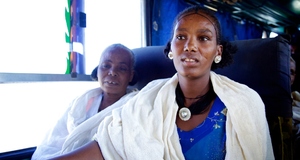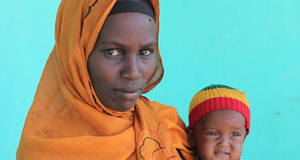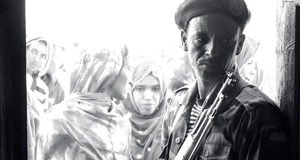From Earth Common Journal VOL. 6 NO. 1Applying the Centrifugal Organizational Model for Pastoralists and Other Competing Communities on the Ethiopian Landscape and the Shift to Agriculture After 1975
By
Earth Common Journal 2016, Vol. 6 No. 1 | pg. 1/1
IN THIS ARTICLE
KEYWORDS
AbstractFor the past four decades, pastoralist activities have been pushed to marginal areas in several regions of Ethiopia. This change was initiated by the Agrarian Land Reform Proclamation of 1974. Pastoralist activities prior to the agrarian reforms were strongly connected to the Earth and developed symbiotically. A connection to the Earth through symbiotic relationships has been shown to foster sustainability. This paper applies the centrifugal organizational model, originally synthesized in the field of plant community ecology, to the changing environment and pastoralism in Ethiopia, demonstrates a shift from periphery habitat to the core habitat with respect to land use since the agrarian reform in 1974, and demonstrates a loss of connectedness with the Earth in regions of Ethiopia. IntroductionIn the latter half of the 20th century, a change from pastoral societies in Ethiopia to an agricultural central core of organization occurred (Ashenafi and Leader-Williams, 2005, p. 549; Beyene, 2010, p. 558). It is important to understand this connection. As of late, the world is feeling the effects of environmental disturbances on a grand scale. Pastoralism in Ethiopia is one of many examples where humans have been in symbiosis with their environment. Based on the information provided, it is my opinion that regaining and maintaining a connection to the Earth is best achieved through the reincorporation of traditional approaches of pastoralism. This paper is born out of the work of Fredrik Barth, who applied an ecological niche theory to the Swat tribes in northern Pakistan (Barth, 1956, p. 1079). Through surveys and observations, he determined Swat tribes were organized in a gradient that places one group at a core and the others progressing outward to the periphery, relative to their economic and political powers (p. 1079). By the same notion, this paper will apply a centrifugal organization model (intended for analyzing plant communities) to the changing relationship to the landscape that pastoralists face in Ethiopia. Though it is unconventional (and risqué) to apply ecological theories meant for plant communities to human groups, the application of Wishue and Keddy's (1992) organizational model, in this case, is compelling. The centrifugal organizational model will be applied to the pastoralist communities (peripheral habitat) in relation to the agropastoral, ranch, and agricultural communities (core habitat). If humans and plants are organisms that interact with their environment, then models of explanation should conform even amidst the high levels of multidimensional complexity that humans bring to the table. The following section will outline the centrifugal organization model for Ethiopian pastoral and agrarian processes (including agropastoral, ranching, and crop communities). Model Features for the Centrifugal Organization ModelModel structure: Core vs. PeripheryThe model has predictive qualities with respect to the future distributions of plant communities (specifically the rare ones) in the peripheral habitats (Wishue and Keddy, 1992, p. 147). Changes in the peripheral habitat affect future distributions of plant communities (p. 147). Given these qualities, I have placed groups into either the core or periphery section of the model based on each group's connectedness to the Earth and level of control over land resources. I believe the core habitat to be least connected, as it does not account for the ecological knowledge of the land and has high control of crop and animal management in the Ethiopian landscape. As Diagram 1 shows, the core habitat is defined as being the now dominant agrarian, agropastoral, and ranching communities. Diagram 1 shows the peripheral habitat, on the other hand, contains pastoralist communities. I believe pastoralists differ from ranchers in that pastoralists graze and water their animals in different land environments, whereas ranchers are mainly sedentary. Though the core and peripheral habitats will be discussed as separate entities, it is important to note they are intrinsically related and affect one another when changes in the environment occur. Disturbance and fertility are elements of change, which determine where each group resides (Wishue and Keddy, 1992, p. 147). I have deemed these elements to be a degree of connectedness to the land. Disturbance is demonstrated by changes in the landscape under some level of control (political, social and economic) exerted on the environment (Beyene, 2010, p. 558; Bogale and Korf, 2009, p. 453). I have defined fertility as resource productivity (herds and crops) and accumulated wealth. This accumulation of wealth is achieved through lineage and social political relationships that foster reciprocity (Oba, 2001, p. 90; Beyene, 2010, p. 558). As Diagram 1 indicates, these elements determine where a group belongs—either the core or periphery—and provide the basic structure of the model. Diagram 1. Centrifugal organization model for Ethiopian pastoral, agrarian, agropastoral, and ranching communities. The pastoral communities are placed in the peripheral habitat and the agrarian, agropastoral, and ranching communities are placed in the core. Note the core and the peripheral habitats show a gradient. The gradient is a result of the underlying mechanism of competitive hierarchy. Adapted from "Competition and Centrifugal Organization of Plant Communities: Theory and Tests," by I.C Wishue and P.A Keddy, 1992, Journal of Vegetation Science 3: 147-156. Model Underlying Mechanism: Competitive HierarchyA cascade of reaction to the changes that have taken place in the Ethiopian landscape evoked the underlying mechanism of competitive hierarchy (Beyene, 2010, p. 561; Bogale and Korf, 2009, p. 454). This interaction is the same mechanism found in Wishue and Keddy's (1992) centrifugal organization model developed for plants. Competitive hierarchy plays an important role in the competition for pastoral and ranch land and agricultural development (Beyene, 2010, p. 561; Bogale and Korf, 2009, p. 454). It is best understood in terms of game theory (Beyene, 2010, p. 561; Bogale and Korf, 2009, p. 454). Bogale and Korf (2009) and Beyene (2010) use game theory models to explain the intricacies of relationships that underlay the types of systems in place in eastern Ethiopia (pp. 454, 561). In the Yerer and Daketa valleys, negotiating communities determine the level of agreement to access land and water (Bogale and Korf, 2009, p. 458). This cooperative relationship is a mechanism of competitive hierarchy at play. The game theory approach provides a model that works to understand the dynamics and complex arrangements between pastoral and agropastoral communities (Beyene, 2010, p. 561; Bogale and Korf, 2009, p. 455). The model uses a tree diagram that explains the options at each point where a decision is faced as to how to proceed with negotiation for access to grazing land and water holes (Beyene, 2010, p. 561; Bogale and Korf, 2009, p. 455). This competition results in a hierarchical community with a strengthened core habitat. Model Feature: GradientGradient is the other inherent feature of the centrifugal model of organization. Wishue and Keddy (1992) use gradient to define specie patterns as markers of the model (p. 147). Gradient can be demonstrated through the personal wealth, ranking, and sociopolitical strategies employed by the pastoralists in the Yerer and Daketa valleys in eastern Ethiopia. Here, pastoralists have an order of importance based on their wealth and ability to maintain stability during times of drought (Bogale and Korf, 2009, p. 459). Stability is reflected in the size of one's herd (Beyene, 2010, p. 555). Pastoralists with many animals have a bigger advantage over pastoralists with few (p. 555). Animals equate to wealth. Currently, wealth appears to be correlated with whether or not someone belongs to a pastoralist or agropastoralist community group (p. 559). Beyene's (2010) work showcases the idea that when individuals move from the core, there is less wealth and sense of belonging for pastoralists (p. 555). Wealth provides security to those in the core, and movement from the core outwards brings with it marginalization and decreased wealth (p. 555). Agropastoral communities also observe this gradient through inequality. Bogale and Korf (2009) performed an exploratory survey of the agropastoral community in the Yerer and Daketa valley (p. 459). Since observed in 2001, access to common grazing land and water resources depends upon membership and land entitlements (Bogale and Korf, 2009, p. 453; Oba, 2001, p. 102; Beyene, 2010, p. 558). This patrilineal system, governed by the elders, manages grazing resources through risk management and sustainability potential analysis (Bogale and Korf, 2009, p. 453; Oba, 2001, p. 102; Beyene, 2010, p. 558). Inequality between the groups demonstrates a gradient and is a model feature that resulted from the social structure of the Yerer and Daketa communities (Bogale and Korf, 2009, p. 453; Oba, 2001, p. 102; Beyene, 2010, p. 558). Agrarian Land Reform Proclamation of 1975The goal of the Agrarian Land Reform Proclamation (ALRP) of 1975 was to discover a way to feed the increasing population in Ethiopia in the face of uncertainty and recurring droughts (Desta and Coppock, 2004, p. 482). The push to increase agrarian production displaced pastoralists and reduced their access to pasture and water (p. 482). After the ALRP of 1975, Ethiopia experienced a shift from a successful pastoralist system (dedicated to risk management) to an agricultural system (Angassa and Oba, 2008, p. 206; Ashenafi and Leader-Williams, 2005, p. 539). Prior to the inception of the proclamation, pastoralist communities effectively managed the landscape and the sustainability of grazing resources through patrilineal descent (Oba, 2001, p. 102). This type of land management held a great connection to the land itself. Sustainability of grazing resources requires a great deal of knowledge of the land, seasonal effects, drought patterns, and other environmental aspects. Oba (2001) believes these traditional systems of pastoral coping strategies have been largely overlooked, and that it greatly affects intergenerational learning (p. 90). Systems like that of the Qero rely on intergenerational learning for the sustainability of the pastoralist communities in the central highlands of Ethiopia (Ashenafi and Leader-Williams, 2005, p. 548). The Qero's common property resource management system saw reforms to land rights and management, creating a more centrally controlled system (p. 548). The Qero system relies on the strict enforcement of rules that mediate the use of land and its resources (p. 548). The drought management systems were based on the understanding of a connection to the landscape and the environment (p. 548). The originating system, though it is far less effective than it once was, still remains through the establishment of "bylaw" regulations (p. 549). This well-functioning Qero system was in place prior to the agrarian reforms of 1975 and was deemed successful in terms of sustainability and drought management (p. 561). The introduced bylaws rendered the Qero system less effective (p. 561). Oba (2001) suggests it is important to recapture some traditional elements that pastoralists contributed, such as coping strategies and successful management of the pastoral lands, in a more inclusive and equitable way (p. 111). There was a time where successful management of risk by pastoralists provided the sustainability of pastoral resources (p. 110). The ShiftThe model for the centrifugal organization of the pastoral, agropastoral, ranching, and agricultural communities on the Ethiopian landscape has experienced reorganization over the past four decades, as seen in Table 1. This shift can be explained through the model of centrifugal organization for human communities in Ethiopia. The Borana rangelands, Yerer and Daketa valleys, and the Guna mountain region provide varied landscapes for analysis. These four locations in Ethiopia show this change in dominance over land use and land resources. Perceived Change in Land UseA community-based analysis was done to assess the perception of the effects of herds and their impacts on areas of ranching, crop farming, cessation of fire use, and changes to the landscape on Borana's rangelands (Angassa and Oba, 2008, p. 201). The cessation of fire, which was traditionally used for the maintenance of the landscape, resulted in fragmentation of the land and bush encroachment, which negatively impacted foraging options for grazing animals, and left the pastoralists vulnerable in times of drought (p. 213). Changing land management resulted in Borana's rangelands being divided into ranches and crop farms (p. 202). The division of land prevented easy passage for pastoralists (p. 213). Angassa and Oba's (2008) analysis determined Borana people perceived the changes as limiting for pastoralists, and that the changes were intimately connected (p. 213). Pastoralist communities in the Yerer and Daketa valleys express concerns that agricultural expansion results in the destruction of grazing land resources and access to them (Bogale and Korf, 2009, p. 454). These concerns are well supported through satellite image analysis of the neighboring Guna mountain region, where a similar decimation of grazing lands has occurred, as seen in Figure 1 and Figure 2. Bogale and Korf (2009) believe the resulting conflict finds resolution through tolerance and negotiations (p. 454). Borana Land Management System Changes in Southern EthiopiaCompetitive markets have developed in an effort to provide Ethiopians with cattle and milk products (Desta and Coppock, 2004, p. 479). This competition has affected the Borana system of pastoral management (p. 479). Changes in this system include reduced cattle-human ratios, increased agropastoralism, more control of private resources, and reduced access to viable water sources (pp. 469, 482). These changes affect the ability of the pastoralists to gain access for their animals to forage and increases poverty and desire for food securities (pp. 475, 476). The results from Desta and Coppock's (2004) inquiry suggest population increases have initiated a change that reduces pastoralism in favour of agropastoralism (p. 481). The Borana system changes provide evidence that peripheral habitats (to which pastoralists have been relegated) are changing as a result of the pressure from increasing populations in need of food (p. 479). The changes in the Borana system demonstrate a movement to core habitat activities and less peripheral habitat activities for the pastoralists (p. 482). Physical Land Use Change and Resource DistributionDocumented proof of land use changes in the west Guna mountain range in the Amhara region of Ethiopia clearly shows the near extinction of the pastoral way of life (Tsegaye, 2014, p. 53). Figures 1 and 2 illustrate satellite images that document the physical changes in the land and land use over a period of 41 years (p. 53). Tsegaye (2014) used satellite images to analyse the changes in vegetation patterns for the years 1973, 1986, 2003, and 2014 (p. 53). In 1973, prior to the agrarian reforms, the land was used primarily for grazing and pastoral activities, as seen in Figure 1. Figure 2 provides a stark contrast in land use and land coverage by 2014. By 2014, the land use and land coverage was primarily agricultural in nature (p. 53). A more agrarian structure is overtly apparent and undeniable. Table 1 displays the distribution of land use/coverage types in all the surveyed years. All land use/coverage types show either increasing or decreasing areas by hectare and percentage. The progression has been documented and shows a shift from the previously dominant pastoral activities to a dominant agricultural system (p. 53). According to Tsegaye (2014), the increasingly dominant agricultural landscape is a result of trying to achieve crop security (p. 59). The process of changing to a more agrarian society decreases forest coverage and increases the desertification of many areas in the west Guna mountain area as seen in Figure 2. Figure 1. Land use/cover map of the Guna mountain range in the region of Amhara in Ethiopia depicting changes from 1973 - 1986. Adapted from "analysis of land Use and Land Cover Change and its Drives Using GIS and Remote Sensing: the Case of West Guna Mountain, Ethiopia" by L. Tsegaye, 2014, International Journal of Remote Sensing and GIS 3(3): 53-63. Figure 2. Land use/cover map of the Guna mountain range in the region of Amhara in Ethiopia depicting changes from 2003-2014. Adapted from "analysis of land Use and Land Cover Change and its Drives Using GIS and Remote Sensing: the Case of West Guna Mountain, Ethiopia" by L. Tsegaye, 2014, International Journal of Remote Sensing and GIS 3(3): 53-63. Prior to the agrarian reform, Table 1 indicates the Guna mountain region allocated 54% of land resources to pastoralist activities—mainly grazing and grassland areas for their herds. In Table 1, Tsegaye (2014) provides documentation of the decreasing grazing and grassland areas in favor of sedentary agricultural and plantation development (p. 57). As grazing and grasslands reduced in area over time, Table 1 indicates there was an opposite and almost equal effect in that the land used for agriculture and plantation development increased in area at a similar rate. Tsegaye (2014) has provided evidence, which physically shows how a sustainable connection to the Earth becomes unhinged. Such land use does not maintain a relationship with the Earth. The loss of connection is more apparent with the increased rock surface and the complete decimation of all natural forests in the Guna region (Tsegaye, 2014, p. 56). Sadly, the forests are now extinct (p. 56). There has been a reduction from 8.5% land coverage, or 2683.7 ha, to zero, as seen in Table 1. Rock land coverage has increased from 205.4 ha to 3095.8 hectares ha from 1973 to 2014 as seen in Table 1. Table 1 shows a marring of the land that has grown at a rate that exceeds that of the forest extinction (p. 56). With no vegetation to hold the Earth together, the soil is exposed to wind, which strips it away, leaving only rock behind where there was once a beautiful forest. Table 1. Images of land use/coverage by hectares (ha) and area (%) of land in 1973, 1986, 2003 and 2014. Adapted from "analysis of Land Use and Land Cover Change and its Drives Using GIS and Remote Sensing: the Case of West Guna Mountain, Ethiopia" by L. Tsegaye, 2014, International Journal of Remote Sensing and GIS 3(3): 53-63. ConclusionA centrifugal organizational model originally developed for plant ecology was applied to pastoralists and their communities in the Ethiopian landscape. Specifically, the model describes the pastoral societies (peripheral habitat) as they relate to the changing landscape, which now favours agriculture, agropastoralism, and ranching (core habitat) (Tsegaye, 2014, p. 57). The underlying mechanism of competitive hierarchy of the centrifugal organizational model is well demonstrated through the use of game theory analysis (Beyene, 2010, p. 561; Bogale and Korf, 2009, p. 454). The interactions within and between groups are organized in a gradient that is dictated by socio-cultural and social political relationships (Ashenafi and Leader-Williams, 2005, p. 549). Competitive hierarchy places ranchers, agropastoralists, and crop farmers at the core, providing for the larger Ethiopian population, while pastoralists have been relegated to the periphery, always searching for a place to graze their animals (Beyene, 2010, p. 561; Bogale and Korf, 2009, p. 454). Thus, gradient applies to wealth, which appears to be correlated with whether or not individuals belong to a pastoralist or agropastoralist community (Beyene, 2010, p. 561; Bogale and Korf, 2009, p. 454). The ALRP of 1975 initiated a change in the landscape with regards to land use/coverage and the apex of change for the shift from the peripheral to core habitats (Angassa and Oba, 2008, p. 206; Ashenafi and Leader-Williams, 2005, p. 539). After this point, a clear disruption of well-established rangeland management systems is seen. There is a clear re-organization of land use documented between 1973 and 2014 (Tsegaye, 2014, p. 57). Changes in land use/coverage over this 41 year period have greatly disrupted what otherwise appears to have been a healthy landscape (Tsegaye, 2014, p. 57). There is much to be learned from pastoralist activities and the healthy sustainable connection they hold to the Earth. The loss of pastoralism equates to a loss of connectedness with our beloved planet. AuthoreliSabeth Noe is a biology anthropology student at MacEwan University in Edmonton, Alberta, Canada. She loves nature and seeks to have a greater understanding of her world through the exploration of education. She has also obtained a Business Administration diploma and a Bachelor's degree in Psychology. She is an avid gardener and strives to live sustainably off the Alberta landscape. ReferencesAngassa, A., & Oba, G. (2008). Herder perceptions on impacts of range enclosures, crop farming, fire ban and bush encroachment on the rangelands of Borana, southern Ethiopia. Human Ecology, 36(2):2012-2015. Ashenafi, Z.T., & Leader-Williams, N. (2005). Indigenous common property resource management in the central highlands of Ethiopia. Ecology, 33(4):539-563. Barth, F. (1956). Ecologic relationships of ethnic groups in Swat, North Pakistan. American Anthropologist, 58:1079-1089. Beyene, F. (2010). Interclan cooperation in a risky pastoral ecology: some lessons from eastern Ethiopia. Human Ecology, 38(2):555-565. Bogale, A., & Korf. B. (2009). Resource entitlement and mobility of pastoralists in the Yerer and Daketa Valleys eastern Ethiopia. Human Ecology, 37(4):453-462. Desta, S., & Coppock, D.L. (2004). Pastoralism under pressure: tracking system change in southern Ethiopia. Human Ecology, 32(4):465-486. Oba, G. (2001). The importance of pastoralists' indigenous coping strategies for planning drought management in the arid zone of Kenya. Nomadic Peoples, 5(1):89-119. Tsegaye, L. (2014). Analysis of land use and land cover change and its drives using GIS and remote sensing: the case of West Guna Mountain, Ethiopia. International Journal of Remote Sensing and GIS, 3(3): 53-63. Wisheu, I.C., & Keddy, P.A. (1992). Competition and centrifugal organization of plant communities: theory and tests. Journal of Vegetation Science, 3:147-156. Suggested Reading from Inquiries Journal
Inquiries Journal provides undergraduate and graduate students around the world a platform for the wide dissemination of academic work over a range of core disciplines. Representing the work of students from hundreds of institutions around the globe, Inquiries Journal's large database of academic articles is completely free. Learn more | Blog | Submit Latest in Environmental Studies |























